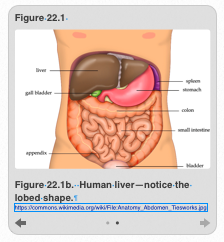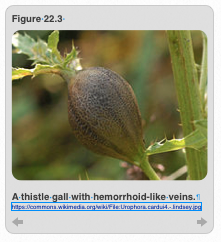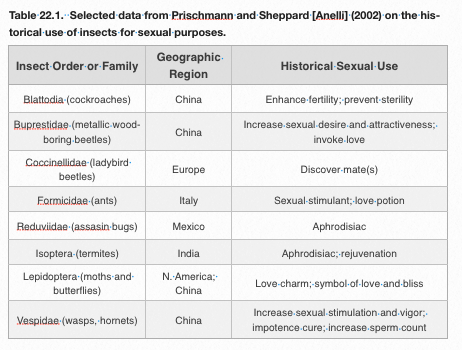Chapter 22 – Insects in Ancient and Modern Medicine

Despite several millennia of collecting and cataloging the organisms that occupy our planet, it is estimated that we’ve only discovered a fraction of the total. This is one of the reasons biologists regularly plead for us to take steps to preserve biological diversity is that. Because of the seemingly inexhaustible expanse of human activities, we are driving an unfortunately large number of the known species to extinction. We have no idea how many of the uncatalogued species are suffering the same fate. Why should we care about organisms with funny names like the Furbish lousewort and the black-footed ferret? There are lots of reasons to care. But, surely one of the biggest and most self-interested of those reasons is that these species may hold the information necessary to cure human diseases. This chapter examines how insects, despite all of the hazards they bring to the relationship with humankind, may also be the source of life-saving cures.
This is a discussion that will span several millennia. First we will look at the kinds of medical solutions insects can offer and how we’ve made use of insects across a swath of history. Next, we will examine the use of insects in modern and current research efforts that have a medical bent. Finally, we will look specifically at insects as wound healers—a process that is ongoing even in modern hospitals!
As long as humans have suffered from medical conditions, they have sought solutions. Sometimes these solutions were rather fanciful from today’s perspective and, certainly, not all of them are underwritten by what we could consider to be evidence of their effectiveness. What is impressive, though, is the diversity of conditions for which insects, at one time or another, were thought to provide remediation. We’ll take a look at several of these that span several millennia from the Doctrine of Signatures to modern anticancer agents.
Insect-based Medicine in the Ancient World
There have been many occasions on which insects were specifically invoked as curative or at least palliative in human medicine. From the System of Pharmacopoeia (1590), we learn that bed bugs can be applied to a gaping wound to staunch the hemorrhaging. No doubt, this was recommended because people from this period were well-acquainted with the blood sucking habits of bed bugs and it simply made sense that bed bugs applied to a wound would do their blood-sucking thing and stop the bleeding.
Another sage piece of advice comes from Friedrich Lesser, whom you already know as the author of Insectotheology. Lesser argued to good effect that because insects exist and because God created all things, that they must have been put here to serve some useful end to humans and we have only to divine what that purpose is. In Lesser’s view, all insects should be cherished—this includes the ones that annoy us or make us sick because God intended them to yield to us some useful service. A quote from Lesser taken from his book, Insectotheology, makes this abundantly clear:
“Every event in nature proclaims that whatever happens is directed by a Being infinitely wise. From this principle it follows that God hath determined the uses of animals in general and of insects in particular, and that he hath destined them to serve, some one purpose, some another. It is not chance, then, that he hath made insects useful, but the eternal decrees of providence; and man hath only turned to his use what was originally intended for his service.”
—F.C. Lesser, Insectotheology: The Being and Perfection of God from a Consideration of the Structure and Economy of Insects (1699)
One of the earliest “theories of medicine” rests upon the idea that the Deity has provisioned nature with all sorts of useful cures. Further, it was widely believed that God had not neglected to make known which natural elements would have useful properties. Indeed, even during times that were much older than the heyday of natural theology, the ancients believed that everything in nature that had a medicinal purpose was invested with a physical sign of whatever it could be used to cure or treat. This idea was codified in the Signature of Signs or Doctrine of Signatures as it was variously called. The governing philosophy was that “like” should cure “like.” Let’s look at how this worked.
The Doctrine of Signatures is both ancient and fairly long-lived, lasting several centuries. The basic idea is that every medicinally useful plant or animal or element bore a physical signature of its usefulness that would inform mankind about what it could be used to treat. All the informed herbalist or naturalist had to do was to look for a physical manifestation of the disease or injury that was revealed in the natural element which could then be used to treat the relevant condition.
Here’s a classic example of this principle in action—the liverwort (Figure 22.1a). If you look at the picture of the plant, the liverwort, and focus on the lobed tips of the plant, you will behold a shape which, with a little imagination, looks a bit like the human liver (Figure 22.1b). The liver, too, consists of lobes.


The previous example involved plants. Herbalists cultivated an active interest in plants and scoured the natural world for things that might be useful in treating human disease. Because plants are loaded with secondary chemicals, this effort paid off enough times to keep faith in this approach alive. It also extended to insects as the following examples will reveal.
Appealing again to the “let likes be cured by likes” philosophy of the Doctrine of Signatures, we see some creative uses of insects to cure various maladies. For instance, the heads of some flies are adorned by very large eyes but almost nothing in the way of hair. Therefore, it was believed that flies should be useful in treating baldness or hair loss in humans. One can find recipes in the ancient literature describing how to make pastes from ground up fly heads to apply on the bald spots to make hair grow. For instance, here’s an example from Pliny the Elder, a first century naturalist, explaining how flies might be prepared for use as a treatment of human baldness:
“The heads of flies, applied fresh to the bald place, is a convenient medicine for said infirmity and defect. Some use, in this case, the blood of flies; others mingle the ashes with the ashes of pear used in old time or else of nuts; with this proportion, that there be a third part only of the ashes of flies to the rest, and therewith for ten days together rub the bare places where the hair is gone. Some there be, again, who temper and incorporate the said ashes of flies with the juice of the colewort and breast milk; others take nothing thereto but honey.”
—Pliny the Elder, Naturalis Historiae.
You can discern that there was a raging debate at the time about whether one should use the blood of the flies or ashes of flies and, if the latter, whether other sorts of ashes should be mixed in. Still others threw plant juices into the mixture. Still others preferred human breast milk. There seems to be something of a consensus that the bald spot should be treated with the fly preparation for about 10 days. A later 18th century author thought it was much more logical to use bees for this purpose since bees obviously have a lot of hair which they use in their pollination activities. This is sort of an alternative school of thought—instead of using a bald insect to treat baldness, why not use a hairy insect to encourage the growth of hair? Indeed, according to Dr. James’ Medical Dictionary from 1743: “If this powder (bee salts) is mixed in unguents with which the head is anointed, it is said to cure alopecia . . .” The logic seems unassailable.

Another area in which the use of insects to affect cures for human diseases was in the realm of problems with the ears. Again, Naturalis Historia (Figure 22.2) was the source of sage advice on this issue. The excessive singing of crickets recommended them as a means to cure both sore throats in which there is an inflammation and ear aches which involves inflammation of an entirely different organ. Crickets are very versatile.
In a sense, Pliny the Elder was late to the party. Some of advice to use insects as a treatment for aural problems is codified in the Old Testament where women are advised to use the hargol, one of the Hebrew words for locust, to prevent earaches. In India, preparations of male crickets were used to control screaming fits—because the voices of crickets while loud and persistent were also under control? It is a bit of a mystery.
A few more examples of insect drawn from the Doctrine of Signatures would have to include the notion that earwigs can be used to fix hearing problems. From one ancient source: “These insects can be dried, pulverised, and mixed with the urine of the hare to cure deafness.” There is a long and storied history on this one. For some reason, it is an urban legend that goes back many centuries that earwigs can crawl into your ears at night and invade your brain causing a variety of problems up to and including death. Despite the persistence of this idea, it is absolute balderdash. Earwigs are not in the habit of invading your brain through your ears. The etymology of the word earwig may be an incorrect translation of the word earwing, something that might have been attached to the earwig because its hind wing looks a little like a human ear in the same way that the liverwort looks a little like the human liver. Try it if you must to cure deafness, but please grind it up first.
We also have some examples of insect behavior rather than shape or color being used under the Doctrine of Signatures. There are many instances of using the prodigious reproductive powers of insects being seen as a sign of their usefulness to humans. From ancient times to modern, insects from many diverse orders have been recommended as a source of virility and fertility. Among the favorites for this purpose, both termites and ants come up for mention here although a lot of insects would seem to share the tendency of prodigious reproduction.
Finally, we have a virtual cottage industry in the medicinal use of plant galls produced by insects that can be used for therapeutic purposes. Technically, galls are produced in an insect-plant collaboration so we need to give credit where it is due. The galls are formed in plant tissue because the insect induces the plant to produce either bigger cells or more cells giving rise to the gall. We have several examples that could be used but we will confine our interest to two. The first is the thistle gall (Figure 22.3) produced by flies. It has been recommended for use in treating hemorrhoids because of the vein-like appearance of the gall tissue. Apparently, to ancient people, it looked like hemorrhoidal tissue.

Another very interesting example is the oak gall produced by tiny cynipid wasp. Interaction of the wasp with oak leaves causes the plant tissue to fill with fluid forming a very large gall (Figure 22.4). The plant has been invaded by the gall wasp, Andiricus kollari, the first sign of which is the appearance of a round mass of tissue in the leaf buds of the oak. Later, the gall will increase greatly in size filling with a spongy mass that will support of the growth of a single gall wasp.

The galls are quite large and contain prodigious amounts of tannic acid. The wasp is interested in tannic acid because the female will lay her eggs inside the gall and they eggs will be protected from predation by the tannic acid. However, enterprising humans have their own uses for the galls. The constituent tannic acid makes a good astringent. An astringent is a chemical that causes tissue to contract and is, therefore, helpful in stopping bleeding on a small scale—like if you cut yourself shaving. Tannic can also be used to treat other kinds of hemorrhages, bleeding ulcers, and gastric bleeding due to the fact that it constricts blood vessels. An ancient remedy, thus, became a modern one. The oak gall industry became very profitable and, up until the middle of the 20th century, galls were collected and imported from Turkey. Later, we acquired a South American source of oak from which the tannic acid can be extracted, which eliminated much of the travel.
While not specifically a medical use, no one can deny the potent effect of plant-derived chemical cantharidin on human physiology. Yes, this chemical goes by a common name—Spanish fly. It’s actually quite toxic meaning its use has to be carefully regulated in ways are not likely to occur given its intended purpose. The chemical is the product of a beetle belonging to the family Meloididae. These are the so-called blister beetles because the defensive compound they produce, cantharidin, can cause blistering. This material has been used medicinally since ancient times to raise blisters when that was thought to be therapeutically useful. Cantharidin is also well known for its capacity to irritate the mucosa in the urogenital tract and, thus, has found prominence as an aphrodisiac. Spanish Fly has appeared in history in some interesting places—such as the writings of the Marquis de Sade who reputedly spiked some pastries with cantharidin at an orgy and fed it to prostitutes who died of cantharadin poisoning. De Sade was sentenced to death for killing the prostitutes although he was later reprieved.
The biological activity of cantharidin gives it diverse uses that are somewhat contradictory. It can cause abortion as well as its well-known aphrodisiac activities. When men take it to enhance their love lives, the symptoms produced include pain, dryness of the mouth, thirst, painful urination, and sustained, painful erection. In women, the irritating effects of the blistering cause a burning sensation in the ureters and urethra. It’s the sort of thing that can definitely ruin your weekend, suggesting another route of pleasure-seeking might be in order.
Cantharidin brings us ineluctably to the realm of Sexual Entomology. We are not kidding, it’s a real thing, most recently described and explained by Prischmann and Sheppard [Anelli] (2002). They performed an exhaustive review of the literature and listed the historical uses of insects for a large number of sexual purposes. The latter included: enhancement of fertility and prevention of sterility; increasing the number and vigor of sperm; aphrodisiacs and rejuvenation of a relationship; stimulation of an erection and prevention of premature ejaculation; and love charms of all sorts. It is astonishing to learn of how many different ways humans have employed insects to assist their love lives. The number of insect orders involved in these undertakings is broad and the nationalities of the humans who employed them is global although China is particularly well-represented. The lack of some countries may simply reflect a paucity of literature in translation rather than effort expended in finding ways to employ insects in romance. Review Table 22.1 (data from Prischmann and Sheppard [Anelli], 2002), and be amazed by the human creativity in appropriating insects for romantic purposes.

Insect-based Remedies in (more or less) Modern Medicine
We’ve already mentioned the use of bed bugs to staunch bleeding. Modern science has revealed an alternative use. Specifically, the bed bug produces proteins that are able to slow bacterial growth and sometimes even kill pathogens. The ability of the bed bug to produce antibiotics may relate to its own odd reproductive habits. As you may remember from our earlier discussion of insect reproduction, although female bed bugs have a functional genital opening and reproductive tract, the male bed bug does not use it. Instead, he literally rips a hole in the female abdominal cavity in a process aptly called traumatic insemination (discussed in detail in Chapter 6). Since the female will be spending some time with a gaping hole in her abdomen, it makes sense that she would produce internal antibiotics to keep her functional until the eggs are laid. And, since a single female may undergo multiple traumatic inseminations, she will need the antibiotics for all of her 1–2 year lifespan. Therefore scientists are turning to bed bugs to identify novel sources of antimicrobial peptides and other immune factors that could be used to combat drug-resistant bacteria.
Other insects produce antibiotics as well. The Cecropia moth (and other insects) produce cecropin A that has bacteriostatic properties. You are well aware that we’re experiencing problems with antibiotic resistance in modern medicine. Cecropin A may represent a viable alternative to the antibiotics that are showing resistance because cecropin A has a novel mode of action to which microbes are not yet resistant.
Prior to the advent of antibiotics, treatment for microbial diseases of all sorts was problematic. Certainly, our inability to treat venereal diseases prior to the availability of antibiotics drove more than one sufferer to try something novel. Diseases like syphilis call out for treatment as, if left untreated, it can have dire consequences such as insanity and death. By 1905, we knew that the causal organism was a spirochete, and a common treatment for syphilis was the use of arsenic-based drugs. This was a “treatment” in name only. Figure 22.5 shows a syphilitic man, covered with lesions, awaiting treatment.

Figure 22.5. Back of a man with secondary lesions from secondary syphilis. Image by Herbert L. Fred, MD, and Hendrik A. van Dijk, CC BY 2.0,
In the early 1900s the treatment common treatment was to place people into a vessel where they were exposed to mercury vapor. Mercury vapor is a well-known nervous system poison. For centuries, people who made hats (called hatters) would use mercury vapor to help bend the band of the hat. As a consequence of the constant exposure to mercury vapor, hatters went quietly insane as a result of the destruction of the nervous system. Lewis Carroll codified this in the Mad Hatter character of Alice in Wonderland.

By 1917, there had been enough experimentation with syphilis and the spirochete that we knew it was heat sensitive and would die if heated to 40oC. This led physicians to try fever therapy. And what would be a reliable way to induce fever? How about by infecting the patient with a malaria-carrying mosquito? The persistent, recurrent fevers associated with malaria were viewed as a mechanism of supplying heat that could kill the spirochete bacteria that caused syphilis. Sometimes, medicine is just a matter of determining the least-bad option. In the case of arsenic vs malaria as a treatment for syphilis, it is hard to pick a winner. Fortunately, by 1928, we had penicillin and the treatment of syphilis took a more humane and effective track.
Is there a greater scourge to mankind than cancer? As other causes of death fall away because we have effective treatments, the importance of cancer to humans increases. Yes, we are finding more and more ways to treat cancer but the goal of eliminating cancer as a cause of human mortality is unfortunately still a long way away. But for our purposes, we should at least ask: will arthropods or arthropod-based products be part of the solution? According to some very important entities, like the National Science Foundation, the National Institutes of Health and Merck Pharmaceutical Company, the answer is “Yes!”
There’s a lot of excitement about using insects for finding new treatments and cures for all manner of human diseases including cancer. In this case, insects present some profound advantages. They are cheap and, usually, easily acquired. It is fairly easy at this point to develop protocols for raising insects in culture. And so far, People for the Ethical Treatment of Animals (PETA) doesn’t seem to mind if we use insects in research, and are less likely to sponsor protests in front of laboratories doing research on insects compared to mammals and other vertebrates. Importantly, insects share many of the same physiological systems and processes with vertebrates. In some cases, the system in insects is not only a good replica of what’s going on in humans but it may be simpler and easier to probe. We are increasingly finding ways to extract an insect organ systems and directly apply chemicals, or therapeutants, of interest to gain a perspective of what would likely happen in human systems. The nervous system of insects is a particularly good example. It can be excised intact from the insects and kept viable so that chemicals of interest can be screened in an insect system before going on to mammals. This, of courses saves money, accelerates the pace of gathering relevant data, and spares sentient vertebrates the role of being experimented upon.
The case for using insects in medical research is increasingly being made from our study of genomics. In such studies, we structurally analyze every gene in an organism’s genome. Once this is done, we can compare the composition of each organism’s genetic constitution with that of every other organism. The research began with the sequencing of the entire human genome by NIH (National Institutes of Health). Since its completion, we have sequenced the genomes of a large number of animals and several insects including honey bees and bed bugs.
A recent comprehensive study compared the human genes with those in four very different species: yeast, flies, worms and mice. The study enabled us to identify which genes that the species hold in common as well as those that are only found in some of the organisms. The study has allowed us to screen for genes that are of interest in human medicine that are also found in other organisms. This, of course, is very useful in deciding which organisms might make good surrogates for testing drugs in non-human organisms as a prelude to humans. Importantly, the findings suggest that there are genes relevant to cancer, neurology, cardiology, morphological aberrancies, and the endocrine system in other species that are similar to the same genes found in humans. It’s all written in the DNA of the respective organisms.
An interesting example of this sort of cross-species usefulness is found in an article published in 2011 in which fruit flies were used to study Alzheimer’s disease. As you are probably aware, human Alzheimer’s is a problem of increasing magnitude as the lifespan of the average person increases. Having a convenient animal model for testing drugs to treat Alzheimer’s disease would be a real asset.
Using data found in genetic studies such as the one referenced above, it was discovered that the gene for Alzheimer’s exists in both humans and fruit flies. This opened up the exciting possibility that we might be able to use fruit flies to test anti-Alzheimer’s drugs to see if they work. This would avoid a lot of very expensive and complicated testing in animal or human trials until it was at least established that the drugs might work. We could also use the insects to screen for side effects prior to human testing. Using the fruit fly, we might be able to rapidly develop a drug that prevents memory loss in humans, which is one of the major disabilities caused by Alzheimer’s disease.
Fruit flies have a lot to recommend them. They have a short life cycle of a couple of weeks. They produce a lot of young per brood and they can produce lots of broods every year. A huge advantage is that Alzheimer’s is a disease that makes changes in the human brain. However, we don’t have any way of visualizing these changes until after death. Thus, we can’t be sure what is happening within any specific human’s brain until a post-mortem analysis occurs. Obviously, that wouldn’t be a problem with fruit flies. And a final advantage is that we can genetically modify the flies to produce Alzheimer’s or the fruit fly equivalent of Alzheimer’s disease.
At this point, it is helpful to learn a little more on the biology of fruit flies. If you place a virgin male (one who has never mated with a female before) into a cage with a female who has already mated, she won’t mate again. The inexperienced male will try to court her but she won’t pay him any attention. The male fruit fly will learn his lesson and carry that lesson over to his next encounter with another female. If the second female has not yet mated and should, therefore, be receptive to the male, the previously-rebuffed male will remember his first experience. Since the memory is unpleasant, he will not be as vigorous in his courtship activities as a male that had not previously experienced rejection.
But if one takes a male fruit fly that has Alzheimer’s disease and puts him through the same series of tests, he won’t remember being rebuffed by the first female and, when presented with the second female, he will court her with undiminished intensity. He will not be able to generalize from his experience with the first female to the second because he doesn’t remember it.
Now, if we take the Alzheimer’s male and treat him with drugs such as lithium that prevent memory loss, like we would like to do in humans, and put him through the mating test, a different result will be forthcoming. The Alzheimer’s male that has received lithium to keep him memory intact will be rebuffed by the first female and remember it. When the second female is presented, like the non-Alzheimer’s male, he will remember the first experience and not court the second female with much enthusiasm. Lithium is available for humans but other drugs are not. Wouldn’t it be great to test them all first in fruit flies?
Another realm in which the fruit fly is proving useful as a research tool is in the realm of nanotechnology. Nanoparticles are extremely small (i.e., 10-9 meters or smaller). Their size is at once an asset and a liability. In the nano-world, scientists can create things that are miniature in the extreme and, perhaps, even at the level of single atoms or molecules. However, the physical forces that operate at the nano-level are different from those that are important at the macro-level causing things to behave differently in the two worlds. And as is often the case with new technologies, our ability to deploy the technology exceeds our ability to track or anticipate the effects of using it. This has led to fear that we may be getting ahead of ourselves in using nanotechnology.
We know intuitively that scale is important in biology. Some nanoparticles are small enough that they may be able to penetrate into living organisms and have unanticipated and unstudied effects on a diversity of organisms. Certainly, the fact that some nano-particles are small enough to move through biological membranes leads scientist to a worry about the potential toxic effects of some nano-products. To date, however, this possibility is largely unstudied. Because nano-particles may not only move through membranes but interact with physiological systems inside of cells, it is not unreasonable to posit that there will be toxicity associated with some nano-products in some organisms. It seems wise to have a basic understanding of this potential before releasing nano-particles in the environment on a large scale.
In a study that employed adult and larval fruit flies, investigators studied what happened to the insects when exposed to nanoparticles that were 1/5,000th the width of a human hair. Larval fruit flies were unaffected by consuming food that was contaminated with nanoparticles. However the reaction of the adult fruit flies was much different. The adults became incapacitated or died when exposed to nanoparticles that they could not remove via grooming activities.
Another important finding of the study was that the particles moved from contaminated flies to uncontaminated flies. The fact that the particles were mobile and that their movement was associated with activities of the flies suggested that nanoparticles will move via similar means in nature. How nanoparticles would behave in the event of a spill of a product that had nanoparticles is a question that must be studied since the laboratory data suggest that widespread movement of the particles could be possible. And, since we are now using many nanoparticle products (e.g., suntan lotion, pharmaceuticals, cosmetics and electronics) it is highly likely that nanoparticles will be released into the environment. As a consequence, there is a compelling need to understand the fate and effects of nanoparticles in diverse environmental settings. Insect-based studies on the biological effects and environmental hazards of nanoparticles seem like an excellent way to get a handle on these issues.
Returning now to the question of using insects as sources of new treatments of human disease, one area of fruitful research is in the realm of diseases that affect the nervous system. The human nervous system is very complicated. We increasingly have technologies that will allow us to measure and visualize what is going on in the nervous system but we would still profit very much from having a simpler surrogate organisms in which to get a first approximation of what sort of activity potential drugs might have and to think about how else we might intervene in the nervous system to fix diverse kinds of problems.
Because we have spent decades creating and testing insecticides, most of which are nervous system poisons, we have a very clear understanding of how the insect nervous system works. We also have a very clear understanding of the differences between insect and human nervous systems. We know a lot, for instance, about the ion channels that the nervous system uses to set up a resting potential in neurons in order to transmit nervous signals.
We know, for instance, which ion channels are critical for the normal function of the nervous system, whether or not they are specific for particular ions and whether or not the channels are likely to be the same or similar in different species. Using this knowledge we can do all sorts of medically interesting things.
One very active area of research is the exploration of insect and arthropod venoms as cures for human diseases. These substances very often affect the nervous system and our knowledge of the similarities and differences between insects and humans is, thus, very important. We now have fairly precise measurements on how things such as scorpion venom affect the aforementioned ion gates. We are acquiring enough knowledge to imagine how highly neurologically active substances such as scorpion venom might be used to treat human diseases.
One major potential application of scorpion venom is treatment of the type of brain tumor known as gliomas. In the image on the left of Figure 22.6 you see glioma cells in the brain of a patient who has not received scorpion venom. Note how dense the cancer cells. In the image on the right of Figure 22.6b you see that the scorpion venome clearly stains and labels the tumor cells blue, making it easier for surgeons to identify the cancerous cells and remove them. Other studies are showing promise in applying the scorpion venom of another scorpion species to the brain where it is able to specifically target and kill cancerous cells. This is a very important finding because of the aggressiveness of the disease, and because some brain tumors are located so far within the brain that they are inoperable. Two very famous people, Ted Kennedy and the columnist Robert Novak were victims of glioma. They were very wealthy people who could pay for the best health care in the world but were powerless to fight glioma.

Image 22.6: Left: pre-operative MRI. Right: an intraoperative Tumor Paint BLZ-100 imaging (Blaze Bioscience)
Every year, 24,000 cases of glioma are diagnosed. A year later, 75% of those diagnosed will be dead. At the present time, the disease is invariably fatal. All of the normal treatment avenues such as surgery, chemotherapy, and radiation are used to slow the disease down but there is still a 98% mortality rate. As a result, new treatments are desperately needed.
In seeking to solve this problem, it is useful to ask why is glioma so lethal? Nerve cells that make up the brain don’t divide—which is why you don’t want to destroy too many brain cells by drinking heavily. Gliomas don’t actually invade the brain cells. Rather, gliomas are cancer cells that form in the covering that surrounds the brain. These so called glial cells do divide and are therefore, subject to cancer. Gliomas just happen to be a very aggressive cancer that invades the non-dividing brain cells and is very difficult to remove surgically.
Because of the inadequacy of current treatment options, physicians have been casting around for new approaches. Scorpion venom and its activity in the nervous system may be just the thing. Doctors can inject scorpion venom directly into the human brain. Researchers have found that the venom does not kill the tumor cells but it does stick to them. As a result of this finding, the light bulb went on and researchers realized that because the scorpion venom has a predilection to find and stick to glioma cells, the venom could be used as a delivery device or a magic bullet. Functionally what has happened is that researchers have attached a toxin that will kill the glioma cell to the scorpion venom which is then injected into the brain. The scorpion venom finds and attaches to the glioma cells and the attached toxin kills the glioma. This is about as close as we get in medicine to specifically targeting and treating cancer cells without poisoning normal cells in the process. It is, in a word, brilliant.

Here we see our friend the scorpion (Figure 22.7). We wouldn’t normally think of the scorpion in that way, but in this instance, the scorpion is a great gift. Who knows what other potential miracles lurk within the phylum Arthropoda?
Insects as Wound Healers
Insects have also saved our tails in another fairly literal sense through their wound healing activities. Read any wartime chronicle and you will become well acquainted with the corruption of flesh torn apart by military projectiles. U.S. Civil war chronicles were particularly rich in this sort of descriptions requiring a strong stomach to endure it. By the time of WWI, we were on the precipice of having antibiotics and maggot-infested flesh would not be such a problem in future wars because of our ability to treat the wounds prophylactically.
Insects were part of the wartime problem but also part of the solution in wars that occurred prior to WW II. One thing that physicians in both the Napoleonic and civil wars realized is that as they triaged patients and sorted out those who might survive with treatment from those who were probably too far gone to treat, sometimes the patients whom they did not treat did better than the ones they did. The doctors noticed that they untreated patients not unexpectedly had deep maggot-infested wounds. And yet, they did better than those whose wounds were kept clean. They also noticed that the maggots trimmed away and cleaned up necrotic tissue around the wounds leading them to believe that the maggots were doing something beneficial to the wound. We now know that in addition to getting rid of dead tissue, the maggots were releasing an antibiotic, allantin, into the wound.
Maggot debridement therapy (MDT), or the use of maggots to clean up wounds, is practiced today. The Ohio State University’s insectarist, George Keeney, will get a phone call from The Ohio State University medical center every year or so asking for maggots to treat a wound that just won’t heal. In response, he’ll send over a vial of maggots and they will take care of the problem. We’ve got that yuck factor to deal with, of course, and one’s insurance may or may not reimburse the cost. But, if we were faced with the choice of losing a limb or using maggots, we would go for the maggots. Here you see a supply of sterile maggots ready to use for MDT (Figure 22.8 – click on link). And Figure 22.9 (click on link) shows the improvement in closure of the wound after the maggot therapy.
Although MDT is not very common, it is found across the U.S. About 70 times a year, someone will order up a vial of maggots to treat a wound. And, of course, this represents a great business opportunity for someone interested in producing pedigreed maggots whose food source is known and approved by buyers.
Before you decide to undertake such a business opportunity, however, it is critically important to know what you are doing. There are many species of insect larvae (maggots) that will invade and eat human flesh. It is vitally important to point out that many of them do not make good candidates for maggot debridement therapy. Among the relevant considerations is whether or not the insect deposits eggs or larvae into a wound. Larvae are harder to disinfect, so it is preferable to use a species that lays eggs in the wound. Another consideration is that the larvae of some species will migrate from the wound site and may invade other organs in the body. Clearly, this would not work well as a maggot therapeutant. The primary species used in commercial MDT is the green bottle fly, Lucila sericata. It is a facultative calliphorid that only eats necrotic or dead tissue, thus, making it perfect for cleaning wounds.
A final note on closing wounds with insects is an ancient technique that enjoys use in modern times. This technique involves using the head, and specifically mandibles, of a biting ant (of several possible species) to close a wound instead of traditional sutures. It is a truly time-tested and approved method still used by indigenous people. Video 22.1 provides a demonstration of how to close a wound using ants. A person holds a live soldier ant (with large mandibles) in one hand with the ant’s mandibles poised over a wound that needs to be closed. The person will squeeze the ant a bit—enough to make her a little angry. The ant will then bite the perceived source of its irritation and as soon as the mandibles are in the man’s skin, he will break the head of the ant off. The ant with closed mandibles in man’s skin pulls the wound shut creating ant stiches. How cool is that?
References
Chapter 22 Cover Photo: Honey. CC0 Public Domain: stevepb. Accessed via pixabay.com
Figure 22.1a: Liverwort plant. CC0 Public Domain: Velela. Accessed via https://commons.wikimedia.org/wiki/File:Lunularia_cruciata.jpg
Figure 22.1b: Human liver. CC0 Public Domain: Tvanbr. Accessed via https://commons.wikimedia.org/wiki/File:Anatomy_Abdomen_Tiesworks.jpg
Figure 22.2: Cover of Naturalis Historiae by Pliny. CC0 Public Domain. Accessed via https://commons.wikimedia.org/wiki/File:Naturalishistoria.jpg
Figure 22.3: Thistle gall. CC-BY-SA 2.5: James K. Lindsey. Accessed via https://commons.wikimedia.org/wiki/File:Urophora.cardui4.-.lindsey.jpg
Figure 22.4: Oak apple gall. By Joe Boggs, OSU Extension. Accessed via http://bygl.osu.edu/node/344
Figure 22.5: Mercury treatment for syphilis. Credit: History of Medicine (NLM). Accessed via https://medicalxpress.com/news/2016-02-world-antibiotics-doctors-infections.html
Figure 22.6: Treating brain tumors with scorpion venom. Copyright 2001 Society for Neuroscience, Photos: Harald Sontheimer, PhD, University of Alabama. Illustration: Lydia V. Kibiuk, Baltimore, Maryland. Available at http://www.brainfacts.org/Brain-Basics/Evolution/Articles/2009/Toxins-and-Venoms
Figure 22.7: Scorpion. CC0 Public Domain: andrey-barsukov. Accessed via https://pixabay.com/en/scorpion-desert-sands-651142/
Figure 22.8: Sterile maggots. Photo by Monarch Labs; Irvine, CA. Available at http://www.livescience.com/17554-maggots-clean-wounds-faster-surgeons.html
Figure 22.9: MDT to heal wounds. Copyright 2007-2012 Biotherapy Medical co., Ltd. All rights reserved. Available at http://www.btmcl.com/eng/
Table 22.1: Selected data on insect use for sexual purposes. From Table 1 in Prischmann and Sheppard [Anelli] (2002). Available at https://academic.oup.com/ae/article/48/4/208/2474686/Love-Bugs-A-world-view-of-insects-as-aphrodisiacs
Video 22.1: Closing a wound using ant mandibles. Video by the CREES foundation. Available at https://www.youtube.com/watch?v=FFGcssKc4gk
Additional Readings
Brown University. “Carbon Nanoparticles Toxic To Adult Fruit Flies But Benign To Young.” ScienceDaily. ScienceDaily, 17 August 2009. www.sciencedaily.com/releases/2009/08/090807103921.htm.
Cherniak, P. (2010). Bugs as Drugs, Part I: insects. The “New” Alternative Medicine. Altern. Med. Rev. 15 (2): 124-135.
McBride, S.M..J., C. H. Choi, B. P. Schoenfeld, A. J. Bell, D. A. Liebelt, D. Ferreiro, R. J. Choi, P. Hinchey, M. Kollaros, A. M. Terlizzi, N. J. Ferrick, E. Koenigsberg, R. L. Rudominer, A. Sumida, S. Chiorean, K. K. Siwicki, H. T. Nguyen, M. E. Fortini, T. V. McDonald, and T. A. Jongens. (2010). Pharmacological and genetic reversal of age dependent cognitive deficits due to decreased presenilin function. J. Neuroscience 30: 9510-9522.
Nyon, G. (2002). Insects Boost Immune System. BBC News, 2/0.02.
Prischmann, D. A. and C.A. Sheppard [Anelli] (2002). A world view of insects as aphrodisiacs, with special reference to Spanish fly. Am. Entomol. 48: 208-220.
Sherman, R.A., M.J.R. Hall, and S. Thomas (2000). Medicinal Maggots: An Ancient Remedy for Some Contemporary Afflictions. Ann. Rev. Entomol. 45: 55-81.